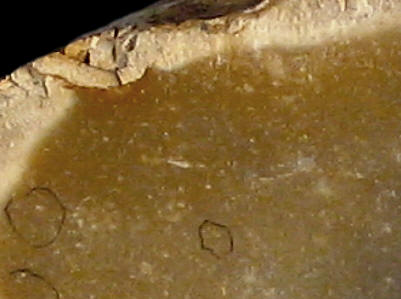
Foto: Jehanne Féblot-Augustins, 2005.
- St-André (Neuville-sur-Ain)
Sampled sites:
| Material name: | CN3a |
| Synonyms: | Silex Senonien |
| Material (geologic): | Late Cretaceous (Senonian) flint |

Foto: Jehanne Féblot-Augustins, 2005. |
Sampled sites:
|
| Mode of occurrence: | Small flat cobbles (8 cm long). |
| Cortex: | Thin (2 mm) alluvial neo-cortex, pale yellowish brown, transition sharp. |
| Colour: | Light olive brown (2.5Y 4.5/4). |
| Pattern: | Pale parallel alignments of submillimetric specks, hardly visible to the naked eye. |
| Appearance: | Very homogeneous material with a greasy lustre, subtranslucent, smooth and very fine-grained. |
| Structure: | Faint fluidal arrangement of grains. |
| Texture: | Mudstone/wackestone. |
| Matrix: | Semi-opaque. |
| Grains: | 10 to 12.5 %, shiny, rounded with high sphericity, or subangular and irregularly shaped (40-80 µ and 100-180 µ). |
| Grain composition: | Globose foraminifera, often surrounded by a halo of recrystallization, a few thin-walled spicules; iron oxides. |
| Further information: | Click here for the original French description (opens in a new window), or here for more information on the attributes used in the description (use your browser's "BACK"-button to return here). |
| Citing: | Information on citing this page can be found here. |
| Locality: | Neuville-sur-Ain / St-André, France, Ain department |
| Synonyms: | Sampling site Bugey 47 after Féblot-Augustins |
| Geographical description: | The material was collected near a slight rise within a large bend of the river "le Suran", just to the NW of St-André, some five kilometres west of Poncin. |
| Geographical co-ordinates: |
east/x 832,5 north/y 2124,8 (Lambert zone II, NTF)
This corresponds with |
| Co-ordinate precision: |
The coordinates given were taken from a large-scale map, and are within approx. 50 metres of the actual spot. The latitude/longitude coordinates are a direct transformation of these data on WGS84 and are accurate to the same level, so don't be deceived by the apparently high precision to the second. The location can be found on the 1:25 000 topographical map sheet 3129 E of the French Institut Géographique National. |
| Geology: |
According to the geological map, the substrate belongs to unit RQ (P1), which consists of residual fluviatile deposits (attributed to the Late Pliocene) with quartzite — and more seldom flint — cobbles. Map of all sampled localities of Late Cretaceous flint in the Bugey (PDF, 54 KB, opens in new window). |
| Type of source: | Secondary. |
| Other types of flint: | Apart from the CN3a-flint described here, also several other flint-types of Senonian age can be found here: CN2a, CN2c, CN3b, and CN4c, as well as Early Cretaceous Ht3 silex. |
thumb.jpg) Foto: Jehanne Féblot-Augustins, 2005 |
| Last modified on: November 25, 2005 |
Contents primarily by: Jehanne Féblot-Augustins |
Comments to: |